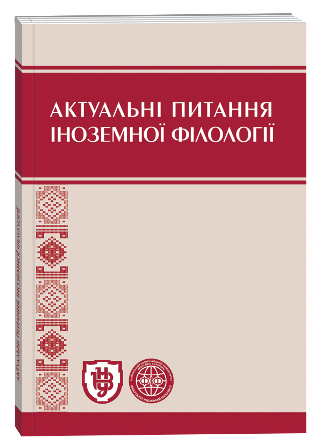REMARKABILITY AS AN INTEGRAL ELEMENT IN THE GENRE OF ENGLISH LITERARY FAIRY TALE
DOI:
https://doi.org/10.32782/2410-0927-2020-13-23Keywords:
semiotics, remarkability, sign, indexicality, coding, sign-symptom, sign-kineme, English literary fairy taleAbstract
The article describes the results of a study devoted to remarkability as an integral element in the genre of English literary fairy tale. In particular, the issues of decoding of a speech sign have been highlighted where a sign, represented by a certain action or situation, conveys another concept or phenomenon. In addition, the semiotic space of English literary fairy tale has been analyzed. Thus it has been determined that the semiotic system helps to combine fiction, a category feature of a fairy tale, and its symbolic nature. The significance of semiotics in the study of a fairy tale narrative has been characterized. The article studies the perspective of research of a literary fairy tale as it becomes more fictional and, as a consequence, more figurative and symbolic where everyday details are side by side with fantastic phenomena. The definition of a literary tale has been represented. It has been outlined that this kind of tale can combine the real and the miraculous, bringing the literary tale closer to life, thereby creating the basis for studying the semantic complexity of the fairy tale narrative and considering the author's idea at different levels of interpretation. The importance of trilaterality of a sign has been analyzed, where, in addition to the unity of the plane of expression and the plane of content, the third element is a reader who receives information by decoding the meaning of the sign that occurs in the text of a fairy tale. It has been considered the classification of signs by Charles Peirce to highlight the ones that are found in a literary tale and the possibility of their interaction. Thus we have defined index signs, namely, signs-symptoms and signs-kinemes. The symptoms are represented as conventional signs for readers which have an implicit character and fill the text with emotional component, while kinemes are conventional, conscious gestures or facial expressions that have a "parasemantic meaning". It has been illustrated the indexicality of a literary tale, where signs are the possible means of expressing not only conventional behavior, but also the hidden content of the emotional state of characters.
References
Biryukov, Boris. 1983. “Znak”. Filosofskiy entsiklopedicheskiy slovar. Moskva: Sovetskaya entsiklopediya.
Borodulina, Natalіya. 2008. “O roli semiotiki v issledovanii yazykovykh znacheniy”. Filologicheskiye nauki. Voprosy teorii i praktiki 1: 18–20.
Braude, Lyudmila. 1979. Skandinavskaya literaturnaya skazka. Moskva: Nauka.
Byalyk, Vasyl. 2012. Epistemolohiya leksychnoho kvantora: monohrafiya. Chernivtsi: Zoloti lytavry.
Kovtun, Yelena. 1999. Poetika neobychaynogo: Khudozhestvennyye miry fantastiki, volshebnoy skazki, utopii, pritchi i mifa (Na materiale yevropeyskoy literatury pervoy poloviny XX veka). Moskva: Izd-vo MGU.
Kubryakova, Yelena. 2004. “O semioticheskikh osobennostyakh proizvodnogo”. Semiotika, lingvistika, poetika: k stoletiyu so dnya rozhdeniya A. A. Reformatskogo 243–249.
Mechkovskaya, Natalіya. 2008. Semiotika: Yazyk. Priroda. Kultura. Moskva: Izdatelskiy tsentr «Akademiya».
Ohuy, Oleksandr. 2012. “Linhvistychna teoriya znaka v epistemolohichnomu rakursi”. Visnyk Zhytomyrskoho derzhav. universytetu im. I. Franka 62: 22–26.
Sossyur, F. de. 1998. Kurs zahalnoyi linhvistyky. Kyyiv: Osnovy.
Byatt, Antonia. 2004. Little Black Book of Stories. Surrey: Vintage, Bookmarque Ltd., Croydon.
Macmillan Dictionary. URL: http://www.macmillandictionary.com
Oxford English Dictionary. URL: http://www.oed.com







